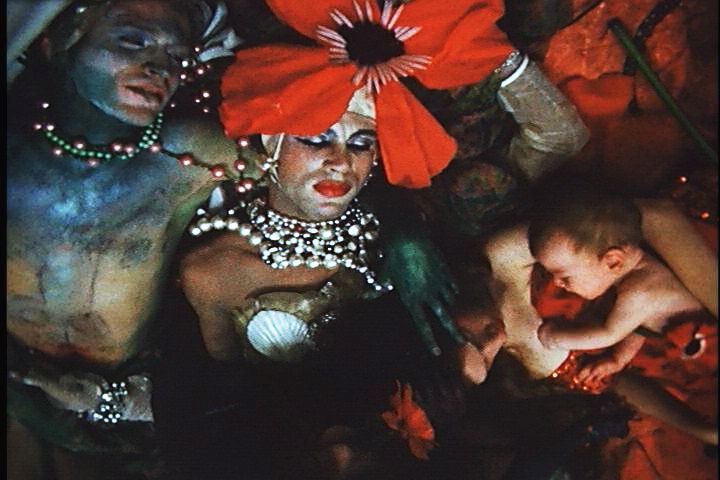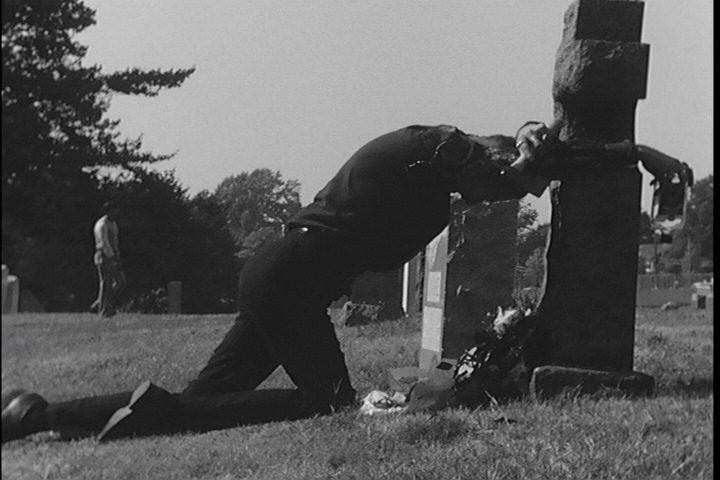Jack Smith was not what we would call a “positive thinker.” He expected the worst from people and from life situations. He was cynical, depressing, and generally a pessimistic man. In life and art he expected the worst and invited failure. He was demanding to a point that he believed his friends, assistants and acolytes were “slaves,” as he himself called them. It almost seemed as if he set up himself and his filmic situations for disaster by establishing near-impossible conditions.
He was, on the other hand, a creative genius who intuitively understood the visual potential of his medium, and would on the spot design his imaginative play between subject and camera (his play with the mirror in Blonde Cobra comes to mind). He was also a confident film editor who seized the moment of projection as the time in which to re-edit his work while in performance, using masking tape to create impromptu “splices.” And, of course, he was a Director who had implicit trust in the shooting situation, so much so that he allowed the shot to extend in time beyond the “normal” length, and enable the emergence of the sublime.
More than twenty years have passed since I began working on the restoration and preservation of Jack’s films. I have often said that I am his last living “slave.” For two decades I have cleaned his films, re- spliced every single one of his makeshift masking-tape “splices,” tried to decipher and respect his editorial decisions and understand his intentions, attempted to ensure that his glorious use of color was reproduced in the exhibition copies of his work, and painfully resisted the temptation to re-edit or re-design any of his work according to my own aesthetic values.
And, despite my best efforts, like all of his “slaves” I inevitably became embroiled in Jack Smith’s battles and feuds, and watched as various egos vied for the supremacy of their own perception of who and what Jack Smith and his work “really” is. (YAWN. I continued re-doing his splices.)
Then, in 2008, the Arsenal Institute of Film and Video in Berlin hosted LIVE FILM! JACK SMITH!, in which his complete, restored oeuvre was shown during “five flaming days,” and audiences were treated to the first public appearance of MARIO MONTEZ after several decades of absence. For my own participation In LIVE FILM! JACK SMITH! I created a short video installation piece that uses some of the excised masking-tape splices which were removed during the restorations. It’s called Remains To Be Seen and can be viewed here.
Around that same time, The Barbara Gladstone Gallery, NY and Brussels took on the role of custodian of the Estate of Jack Smith. The gallery created an archive for his films, photography and static art works, and, with a firm commitment to upholding the aesthetic integrity of his work, continues the task of restoration, preservation and exhibition, enlisting my help in these undertakings.
Today, in 2013, I find myself once again sitting in front of a MovieScop Viewer, hand-cranking my 16mm rewinds, and executing hot splices and guillotine-tape splices on Jack’s Kodachrome camera original and Ektachrome work prints, while listening to his ¼-inch reel-to-reel tape recordings.
This time, however, with the support of The Gladstone Gallery, I have access to his writings, notes and ephemera, as well as all of the film and media-related material in one place. This has made the current restoration project much easier. There are several newly restored works that will be coming out of these efforts.
Hamlet in the Rented World is one of these pieces. As early as 1972, Jack had been working on an improved version of the Bard’s play. Stefan Brecht notes in his book, Queer Theatre, that Jack felt the play was
…very badly written, no structure, more like a radio or TV series, but can be salvaged by much cutting. Only the good lines are to be retained. It will be in the family: just Hamlet (Jack Smith), Gertrude (Marie Antoinette, one of Vaccaro’s actresses), Ophelia (Silva – a drag Queen I don’t know), and Plodius (Polonius + Claudius, – to be played by myself). It will be Jack’s first talking movie, in lush colors. The U-P film studio will help with the sound…
I have found some of the film material in the Smith Archive. The material is largely unedited, and therefore, following my own guiding principle of film preservation, it will remain so. Audiences will see the material in the same form that Jack himself last saw it.
The film, however, is not the only Hamlet in the archive. Typical of Jack Smith is his cross-media/cross-art form methodology. (Yes, Jack had a method!) He staged at least one Live Performance of Hamlet and the 1001 Psychological Jingoleanisms of Prehistoric Landlordism of Rima-Puu for which there is 35mm slide documentation. He also left behind several different typed scripts (some running to about 40 pages) which were either intended as shooting scripts for the uncompleted film or for the actualized performances. The title on some of these scripts reads Hamlet in the Rented World while others are titled Hamlet and the 1001 Psychological Jingoleanisms of Prehistoric Landlordism of Rima-Puu.
There are also several ¼-inch reel-to-reel tape recordings of Jack as he is reading selected lines from some of these scripts. These tapes reveal themselves to be more than merely “wild sound” (that is, unsynched audio) for the 16mm film. It seems that these tapes are themselves a kind of audio-performance of the scripts. With his usual aplomb, Jack rehearses and repeats a single line over and over again, apparently feigning dissatisfaction with his own delivery, then repeating exactly the same line with the same style of delivery.
At first it was tempting to try to match these reels to the picture, until it became clear there was no narrative connection between the two. As usual, Jack Smith invites us to wade with him into the swamp of uncertainty where we can expect to be surprised by his humor and political acumen.
The current excavation of the archive has also yielded some fascinating shorter films that are being assembled onto a single reel for viewing. This reel, which will be titled GEMS, CLIPS, AND SHORTS, is a collection of pieces that are complete executions of a single, cinematic, visual idea featuring one or more of Jack’s notorious “Creatures”: Mario Montez, Tally Brown, Irving Rosenthal and Silva, the drag queen mentioned by Stefan Brecht, above. Like almost all of his films, the narrative is obscure or completely dismantled, yet there is a driving filmic purpose in each of them.
Similarly there are several longer films that he may have been used as part of his many “Live Film Performances,” or which he may have screened as stand-alone works. The five that have come to light thus far are: Boiled Lobster of Lucky Land Lady Lagoon (also identified as Color Heatwave of Tabu), Exotic Landlordism, Hatchet Picnic, and newly remastered versions of Buzzards Over Baghdad, and Sinbad of Baghdad.

From Exotic Landlordism, courtesy of Jack Smith Archive and Gladstone Gallery, New York and Brussels
Together these newly-restored films will bring a new understanding and appreciation of the work and life of Jack Smith. Judging by appearances, it would seem that he expected no great outcome from his work. He anticipated failure and sometimes even created the conditions that would invite it. Yet, through his sometimes paranoiac outbursts, he had an unflagging demand for perfection in his creative process, and a willingness to endure the kind of sacrifices in his life that most of us would never tolerate.
Jack’s life and work were intertwined in “failure”—described as a Glorious Catastrophe by Dominic Johnson in his seminal study of that name:
He abandons himself to failure, and offers consolations for its inevitability in the spaces between art and the everyday. Such spaces are often sexual, not least because sex is the province of ardour and energy, of intimate exertions, but also of failures, inasmuch as intimacy is frequented by incomprehension, misrecognition, and other meagre humiliations. Smith strays into catastrophe because his work was a persistent attempt to take stock of and attend to the disasters of a life.
This was just what he expected!
To learn more about the new restoration of the work of Jack Smith, or any of the films, books, or works cited:
Visit www.jerry501.com and contact Jerry Tartaglia.



This is such important work you are doing. I love the hands on aspect of the project, imagining you touching each and every frame, Jack Smith leading, or shall I say dragging, you along all the way. The vibrancy of his vision continues to shine in all its Kodachrome glory, thanks to you Jerry Tartaglia!
Hi Jerry,
Just learned from a friend about the screening at the Anthology, sorry I missed it! I am Ching ho Cheng’s sister. I handle his estate and help with Tally Brown’s estate. Tally was family to me.
How wonderful you are taking care of Jack’s legacy!
Please let me know when there is another screening.
Thank you!
Sybao
wow! beautiful work.
and I hadn’t known that there was any visual record of the Hamlet Stefan (my husband and longtime friend) wrote about… I’ll try to see that, and hope to see more.
thanks so much
Rena Gill